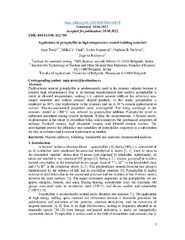Приказ основних података о документу
Application of pyrophyllite in high-temperature treated building materials
| dc.creator | Terzić, Anja | |
| dc.creator | Vasić, Milica V. | |
| dc.creator | Stojanović, Jovica | |
| dc.creator | Pavlović, Vladimir B. | |
| dc.creator | Radojević, Zagorka | |
| dc.date.accessioned | 2023-11-03T12:51:37Z | |
| dc.date.available | 2023-11-03T12:51:37Z | |
| dc.date.issued | 2023 | |
| dc.identifier.issn | 2683-3867 | |
| dc.identifier.uri | https://doiserbia.nb.rs/Article.aspx?ID=0350-820X2300014T | |
| dc.identifier.uri | http://aspace.agrif.bg.ac.rs/handle/123456789/6467 | |
| dc.description.abstract | Phyllosilicate mineral pyrophyllite is predominantly used in the ceramic industry because it exhibits high refractoriness. Due to its thermal transformation into mullite, pyrophyllite is stable at elevated temperatures, making it a suitable mineral additive for refractory non-shaped materials and various ceramic shaped products. In this study, pyrophyllite is employed as 50 % clay replacement in the ceramics and up to 30 % cement replacement in mortars. Physico-mechanical properties were investigated. The firing shrinkage in the ceramics treated at 1200 °C was reduced by pyrophyllite addition. Pyrophyllite acted as additional pozzolana during cement hydration. Within the microstructure, it formed micro-reinforcement in the shape of crystalline folia, which improves the mechanical properties of ordinary Portland cement, high aluminate cement, and blended cement mortars. The investigation proved the efficiency and suitability of pyrophyllite employed as a substitution for clay in ceramics and a cement replacement in mortars. | |
| dc.description.abstract | Phyllosilicate mineral pyrophyllite is predominantly used in the ceramic industry because it exhibits high refractoriness. Due to its thermal transformation into mullite, pyrophyllite is stable at elevated temperatures, making it a suitable mineral additive for refractory non-shaped materials and various ceramic shaped products. In this study, pyrophyllite is employed as 50 % clay replacement in the ceramics and up to 30 % cement replacement in mortars. Physico-mechanical properties were investigated. The firing shrinkage in the ceramics treated at 1200 °C was reduced by pyrophyllite addition. Pyrophyllite acted as additional pozzolana during cement hydration. Within the microstructure, it formed micro-reinforcement in the shape of crystalline folia, which improves the mechanical properties of ordinary Portland cement, high aluminate cement, and blended cement mortars. The investigation proved the efficiency and suitability of pyrophyllite employed as a substitution for clay in ceramics and a cement replacement in mortars. | |
| dc.relation | info:eu-repo/grantAgreement/MESTD/inst-2020/200012/RS// | |
| dc.rights | openAccess | |
| dc.rights.uri | https://creativecommons.org/licenses/by/4.0/ | |
| dc.source | Science of Sintering | |
| dc.source | Science of Sintering | |
| dc.subject | Mineral additives | |
| dc.subject | Sintering | |
| dc.subject | Sustainable raw materials | |
| dc.subject | Instrumental analyses | |
| dc.title | Application of pyrophyllite in high-temperature treated building materials | |
| dc.type | article | en |
| dc.rights.license | BY | |
| dc.citation.epage | 397 | |
| dc.citation.issue | 3 | |
| dc.citation.spage | 383 | |
| dc.citation.volume | 55 | |
| dc.identifier.fulltext | http://aspace.agrif.bg.ac.rs/bitstream/id/24908/Application_of_pyrophyllite_pub_2023.pdf | |
| dc.identifier.rcub | https://hdl.handle.net/21.15107/rcub_agrospace_6467 | |
| dc.type.version | publishedVersion |


